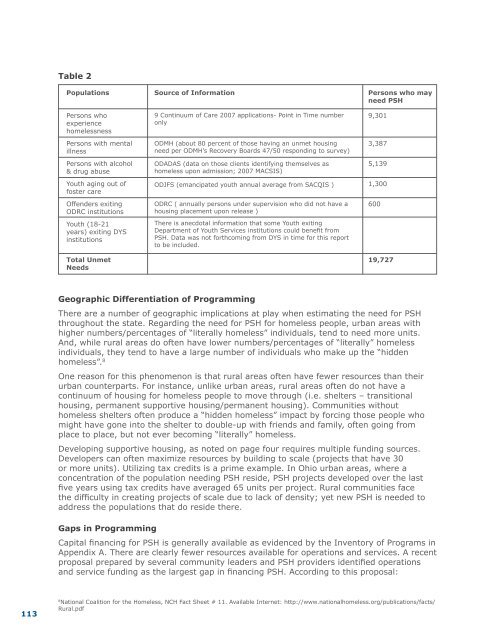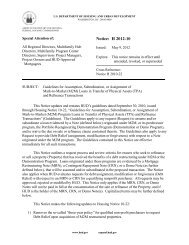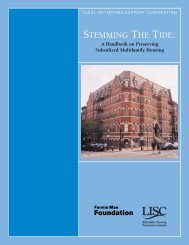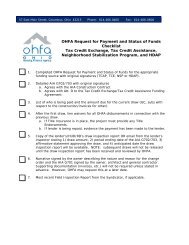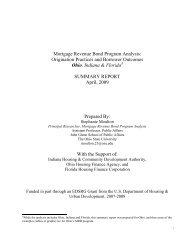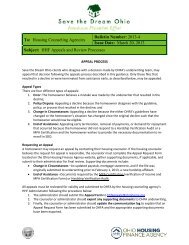One indication that the CoC point-in-time counts do not fully represent the need for PSH in<strong>Ohio</strong> is that local community unit goals for PSH far surpass the HUD numbers. For example,Table 1 establishes that the need for PSH in Columbus, <strong>Ohio</strong>, for homeless persons is 474units. These estimates are in line with the methodology that HUD requires for its CoCapplication but does not align with Columbus and Franklin County’s Rebuilding Lives plan,which calls for 1,550 units. Columbus, like other communities, conducted a much moreextensive study to determine the needed number of PSH units for homeless persons.Columbus’ study calls for 1000 units more than called for in the CoC chart. The differencebetween the HUD number and the number estimated by the community is brought aboutby the fact that single point-in-time data produces different results than annual numbers ornumbers across multi-years. <strong>Annual</strong>ized data, and comparisons of numbers over multipleyears, shows greater need.PSH Targeting other Vulnerable PopulationsTable 2 approaches the statewide “unmet need” for permanent supportive housing ina different way than HUD’s CoC. State agencies, local communities and providers ofservices recognize that certain populations that have disabling conditions or lack skills andcommunity supports to stay stably housed can also benefit from permanent supportivehousing.The populations identified were “counted” using various methods as determined by the stateagencies providing the data. On an annual basis 10,426 people were identified throughthese means to need supportive housing. If the additional population of homeless personscounted on one night is added than 19,727 people in <strong>Ohio</strong> need PSH.The numbers of people needing PSH is not directly equitable to the number of units ofpermanent supportive housing. In addition, day counts are not equitable to annualizednumbers of persons. The Corporation for Supportive <strong>Housing</strong> (CSH) recognizing thechallenges in converting persons to units has published a manual to help communitiesestimate the need for permanent supportive housing 7 . The CSH <strong>Ohio</strong> office has offeredits assistance to the State of <strong>Ohio</strong> in completing this exercise. Other consultants, suchas the University of Pennsylvania and the Urban Institute, have provided this service tocommunities as well.In light of the various methodologies utilized by state departments in collecting thisinformation, like the CoC point-in-time data, these estimates very likely also underrepresentthe need for permanent supportive housing throughout the state.Table 1Unmet need for PSH for homeless population, estimated based on single day, point-in-time countAkron Balance Canton Cincinnati Cleveland Columbus Dayton Toledo Youngstown Total TotalSummit of State Stark Hamilton Cuyahoga Franklin Mont- Lucas Mahoning Units PeoplegomeryUnits for 35 355 51 50 372 15 175 22 12 1,087 3,805familieswithchildrenUnits 157 157 422 65 300 3498 459 445 106 44 5,496 5,496forindividualsTotal 192 777 116 350 3870 474 620 128 56 6,583 9,3017Corporation for Supportive <strong>Housing</strong>, Estimating the Need: Projecting from Point-in-Time to <strong>Annual</strong> Estimates of the Number ofHomeless People in a Community and Using this Information to <strong>Plan</strong> for Permanent Supportive <strong>Housing</strong>, Available by Internet:http://www.csh.org/index.cfm?fuseaction=document.showDocumentByID&DocumentID=773&C:\CFusionMX7\verity\Data\dummy.txt112
Table 2PopulationsPersons whoexperiencehomelessnessPersons with mentalillnessPersons with alcohol& drug abuseYouth aging out offoster careOffenders exitingODRC institutionsYouth (18-21years) exiting DYSinstitutionsTotal UnmetNeedsSource of Information9 Continuum of Care 2007 applications- Point in Time numberonlyODMH (about 80 percent of those having an unmet housingneed per ODMH’s Recovery Boards 47/50 responding to survey)ODADAS (data on those clients identifying themselves ashomeless upon admission; 2007 MACSIS)ODJFS (emancipated youth annual average from SACQIS )ODRC ( annually persons under supervision who did not have ahousing placement upon release )There is anecdotal information that some Youth exitingDepartment of Youth Services institutions could benefit fromPSH. Data was not forthcoming from DYS in time for this reportto be included.Persons who mayneed PSH9,3013,3875,1391,30060019,727Geographic Differentiation of ProgrammingThere are a number of geographic implications at play when estimating the need for PSHthroughout the state. Regarding the need for PSH for homeless people, urban areas withhigher numbers/percentages of “literally homeless” individuals, tend to need more units.And, while rural areas do often have lower numbers/percentages of “literally” homelessindividuals, they tend to have a large number of individuals who make up the “hiddenhomeless”. 8One reason for this phenomenon is that rural areas often have fewer resources than theirurban counterparts. For instance, unlike urban areas, rural areas often do not have acontinuum of housing for homeless people to move through (i.e. shelters – transitionalhousing, permanent supportive housing/permanent housing). Communities withouthomeless shelters often produce a “hidden homeless” impact by forcing those people whomight have gone into the shelter to double-up with friends and family, often going fromplace to place, but not ever becoming “literally” homeless.Developing supportive housing, as noted on page four requires multiple funding sources.Developers can often maximize resources by building to scale (projects that have 30or more units). Utilizing tax credits is a prime example. In <strong>Ohio</strong> urban areas, where aconcentration of the population needing PSH reside, PSH projects developed over the lastfive years using tax credits have averaged 65 units per project. Rural communities facethe difficulty in creating projects of scale due to lack of density; yet new PSH is needed toaddress the populations that do reside there.Gaps in ProgrammingCapital financing for PSH is generally available as evidenced by the Inventory of Programs inAppendix A. There are clearly fewer resources available for operations and services. A recentproposal prepared by several community leaders and PSH providers identified operationsand service funding as the largest gap in financing PSH. According to this proposal:1138National Coalition for the Homeless, NCH Fact Sheet # 11. Available Internet: http://www.nationalhomeless.org/publications/facts/Rural.pdf
- Page 3 and 4:
OHFA Annual PlanThe Ohio Housing Fi
- Page 5:
Mission StatementsThe OHFA Annual P
- Page 8 and 9:
The State’s Housing NeedsAffordab
- Page 10 and 11:
Subject Matter Expert (SME) Workgro
- Page 12 and 13:
3. Financial LiteracyOHFA and other
- Page 14 and 15:
Affordable Housing Preservation & D
- Page 16 and 17:
federal subsidies. To achieve this
- Page 18 and 19:
Accessible HousingBackground DataOh
- Page 20 and 21:
3) Create dedicated funding streams
- Page 22 and 23:
• Recommend that Ohio support the
- Page 24 and 25:
Rural and Appalachian RegionsBackgr
- Page 26 and 27:
6. Annual Set-Asides and Incentives
- Page 28 and 29:
• Several cities in Ohio current
- Page 30 and 31:
OHFA should provide funding, traini
- Page 32 and 33:
Permanent Supportive Housing Produc
- Page 34 and 35:
3. The State should assist local Co
- Page 45 and 46:
PrioritizationThe challenge of prio
- Page 47 and 48:
Agency RecommendationsThe Annual Pl
- Page 49 and 50:
APPENDIXWorkgroup 1: Affordable Hom
- Page 51 and 52:
Executive SummaryHousing Need Descr
- Page 53 and 54:
efficiency and resource conservatio
- Page 55 and 56:
554. Home Buyer Education in OHFA F
- Page 57 and 58:
Estimated Units in Need of Some For
- Page 59 and 60:
Ohio County Foreclosure Filings (19
- Page 61 and 62: Operating Costs - Met and Unmet Nee
- Page 63 and 64: Workgroup #2:Affordable Housing Pre
- Page 65 and 66: Secondary Recommendations• Explor
- Page 67 and 68: Executive SummaryOhio’s supply of
- Page 69 and 70: Met Housing Needs (“Resource Inve
- Page 71 and 72: Ohio Deptof MentalRetardation andDe
- Page 73 and 74: Unmet Housing NeedsData OverviewThe
- Page 75 and 76: ody, and will be built within the C
- Page 77 and 78: • OHFA will continue to maintain
- Page 79 and 80: Best Practices, Policies and Progra
- Page 81 and 82: addition, 60,111 one-person househo
- Page 83 and 84: Across Ohio, people with very low i
- Page 85 and 86: • Responsible for Rent - The pers
- Page 87 and 88: Seattle, St. Louis, and Washington,
- Page 89 and 90: Primary Recommendations• Create a
- Page 91 and 92: Unmet Housing Needs:• Due to the
- Page 93 and 94: • The cost of construction often
- Page 95 and 96: Recommendations for Annual Plan Adv
- Page 97 and 98: capacity to quantify vacant propert
- Page 99 and 100: distributed on or about January 15,
- Page 101 and 102: Action is needed at the State level
- Page 103 and 104: a “user-friendly” data system,
- Page 105 and 106: 5) Incentivize the formation of bro
- Page 107 and 108: Workgroup #8:Permanent Supportive H
- Page 109 and 110: 3. Assist local Continuums of Care
- Page 111: Program and Resource InventoryNonpr
- Page 115 and 116: Examples: A national model for succ
- Page 117 and 118: oles, so they create a contract bet
- Page 119 and 120: Workgroup #8:Appendix ANameProgramD
- Page 121 and 122: or remedyingneglect, abuse,or the e
- Page 123 and 124: ased healthcare, and earlyintervent
- Page 125 and 126: “Bob” of Stark County, OhioPubl


